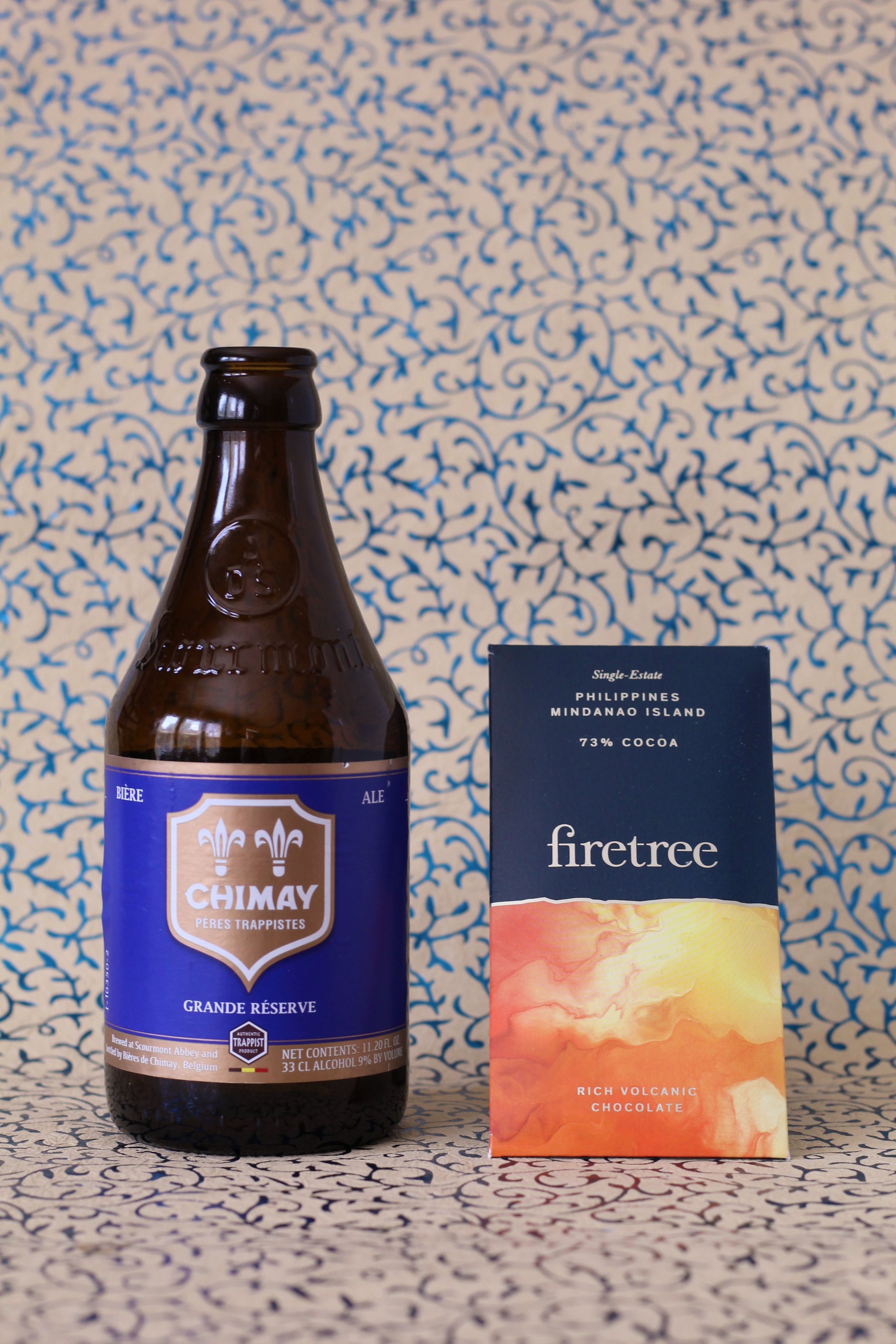Pairings Belgian Dark Strong Ales with Craft Chocolate
Belgian Dark Strong Ale is a bit of a catchall category, encompassing Abbey Quadrupels and quite a few unusual, brewery-specific beers. Belgian brewers don’t sweat our style guidelines too much, so there is a lot of variation represented within this category. The vast majority of beers under the Belgian Dark Strong Ale umbrella are in fact Quadrupels, so we’ll use the terms interchangeably for the purposes of this guide, but know there are some one-offs out there that will break the mold (and the rules).
First off, let’s address the name “Quadrupel.” This is the strongest of the traditional Abbey styles, which also include Single, Dubbel, and Tripel. While these beers do typically increase in alcohol strength as we move from Single to Quad, those multipliers don’t actually directly relate to anything (i.e., a Tripel isn’t three times as strong as a Single, doesn’t use three times as much malt, etc). In fact, we’re not entirely sure where those style names originally came from. Westvleteren first brewed a beer in this style in the mid-twentieth century, but the term "Quadrupel" was first used at La Trappe in 1990, long after the “Dubbel” and “Tripel” monikers had been coined.
Description
Belgian Dark Strong Ales/Quads are quite strong, typically ranging from 8-12% ABV. While they are “dark,” this presents more as a red/brown color rather than the dark brown/black of Porter and Stout styles. Much of the color often comes from dark sugars that are used to boost alcohol content without leaving behind a heavy body.
These beers present a complex balance of malt and fermentation flavors, with dark bread, dark sugar/caramel, dried and stewed fruits, subtle spice, and gentle perfumy alcohol notes. Belgian ale styles typically use expressive yeast strains that contribute a range of subtle fruit and/or spice notes, and these are likely to be found in Quads. These beers often have a warming perception from their alcohol content, and a full, creamy mouthfeel despite finishing fairly dry. The best examples pull off a bit of a magic trick by presenting an indulgent, rich flavor profile, but actually being relatively lean and dry on the palate.
Examples—Chimay Grande Reserve (aka Chimay Blue), Straffe Hendrik Quad, La Trappe Quadrupel, Rochefort 10, Ommegang Three Philosophers, Taxman Qualified, St. Bernardus Christmas Ale and Abt. 12, Troegs Mad Elf.
Pairing with Chocolate
The notes of caramel, dark bread, dark fruit, and gentle spice typical of these beers allow for many flavor bridges to a range of chocolate types, though the style doesn’t come without its challenges with chocolate.
Challenges When Pairing—Despite often having a sweet flavor perception, these beers generally don't have much residual sugar. This dryness can be exposed in harsh and bitter ways by chocolates with rough edges of their own. Additionally, the alcohol heat of these strong beers can be rendered solventy by some pairings.
Chocolates to Seek Out—Quadrupels are often excellent candidates for experimenting with single origin dark chocolates due to their complex but cushy flavor profiles and impression of sweetness. They have a lot going on to generate flavor hooks for a pairing, but very few sharp edges (e.g. roast, hop bitterness, etc). That makes Belgian Dark Strong Ales the rare style that has a lot of flexibility for pairing with single origin dark chocolate bars, which are notoriously hard to provide pairing guidance for. Grab some single origins bars in the 70-80% range, particularly those with fruitier notes, and a Belgian Dark Strong Ale/Quadrupel and see what your favorite is!
These beers can also work well with bars using rounder, gentler spice inclusions like vanilla or licorice root.
Avoid When Pairing—Most bars under 65% will get washed out by Quads, and most over 80% will be too bitter. Bars with most spice additions—which may pair well in concept—often become harsh and bitter when they meet this style’s high alcohol content and relative dryness.
Examples
St. Bernardus Christmas Ale is a more indulgent example of a Belgian Quad, with a fuller body and a bit of residual sweetness. The brewery is not connected to a monastery, but they used to contract brew Westvleteren 12, so they’re highly esteemed among brewers of this style. The beer balances out the black tea notes of Argencove’s Apoyo Nicaragua 70% bar to create the impression of acidic caramel over raisins.
Grande Réserve is the most regal and esteemed of the Chimay line of Trappist ales. Grande Réserve was first brewed in 1954 as a Christmas beer before eventually migrating to the year-round list.
Grande Réserve has notes of plum and dried fruits, with a creamy and full perception that belies a relatively dry body. You might pick up flavors of dark, sweet bread, and as the beer ages, you might get more oxidative flavors of tobacco or sherry.
One bar in particular that dances gracefully with this bold beer is Firetree Philippines Mindanao Island 73%, an earthy, “chocolatey” bar with subtle fruit notes of orange and banana. The pairing yielded the impression of rich brownies made with a fruity chocolate origin. For two complex halves, the whole was luxuriously simple.

